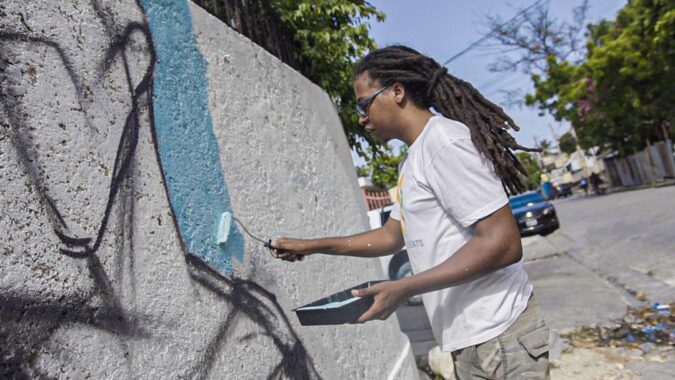« I found myself sick for three years, experiencing symptoms such as recurring dizziness, fever… », attests a sculptor interviewed by AyiboPost
The use of paints and aerosol cans without adequate protection by artists in Haiti leads to discomfort and sometimes chronic illness, according to testimonies gathered by AyiboPost.
A sculptor since 2018, Wiss Jims is frequently in contact with resin, a chemical component found in paint.
By not wearing a mask, the artist regularly exposes himself to large quantities of the substance known to cause allergic reactions.
Jims began to experience inflammation in his throat.
« I found myself ill for three years, experiencing symptoms such as recurring dizziness, fever, heart palpitations, respiratory problems, aches and pains and severe fatigue, » he testifies to AyiboPost.

Wiss Jims poses for a photo in front of one of his sculptures in progress, at 40%, on February 2, 2023. | © Faccebook Wiss Jims
Despite multiple medical consultations, no precise illness could be diagnosed in Jims, who had to stop working. « Each exposure to resin systematically triggers the same symptoms, » he says.
Indeed, the use of resin can lead to allergic reactions to the skin, eyes or respiratory tract.
According to Michelet Estève, a chemist and engineer by training, paint is made up of several elements.
Firstly, binders such as resin or polymer ensure cohesion between the components of the paint. Secondly, solvents dilute pigments and binders, facilitating paint application while promoting evaporation for rapid drying.
Discover : Photos | À la rencontre des 14 créateurs qui illuminent la 277e exposition du Centre d’Art
These solvents can be organic (such as hydrocarbons, ketones and esters) or water-based.
Finally, additives, pigments and fillers are used to adjust various physical properties of the paint, such as texture and gloss.
Unprotected users are exposed to health risks, particularly due to the use of toxic pigments in certain paints.
I found myself ill for three years, experiencing symptoms such as recurrent dizziness, fever, heart palpitations, respiratory problems, aches and pains and severe fatigue.
According to a scientific study conducted by Drs. Shelley-Rose Hyppolite and Robert Plante of the Médecin du Québec in February 2004, inorganic pigments containing toxic metals present the most significant hazards.
The pigments most commonly used in artists’ paints, such as lead, cadmium, manganese, cobalt and mercury, are among the most worrying, say the researchers.
These toxic metals can cause respiratory and gastrointestinal problems, cardiotoxic effects, memory impairment and dermatological problems, among others.
Also see : Meeting the CCC-uniQ, committed to the restoration of Haitian art
Solvents are not without their implications either, explain the researchers. Present in brush cleaners, thinners and mediums used in oil paints, they are classified in various categories depending on the chemical used in their composition.
These solvents can cause dermatological, neurological, pulmonary and renal complications, according to the researchers. These chemical compounds, they say, have the ability to interact with the individual’s body through various means, including the respiratory, cutaneous or digestive tracts. This interaction can lead to disruptions in the body’s normal functioning, with both immediate and potentially long-lasting consequences.
The pigments most commonly used in artists’ paints, such as lead, cadmium, manganese, cobalt and mercury, are among the most worrying, say researchers.
Haitian artists also use lead-based paints. These paints are a common source of poisoning.
According to research, lead causes long-term damage in adults, including an increased risk of high blood pressure, cardiovascular problems and kidney damage.
In 2020, a Global Alliance for the Elimination of Lead Paints created by the World Health Organization (WHO) and the United Nations Environment Programme (UNEP) expressed the wish to eliminate these paints.
Spray cans, particularly those used by graffiti artists, also cause problems when used without appropriate protection.
Also see : Istwa grafiti nan peyi Dayiti
According to an article published in March 2019 by the Red Bricks Cultural Association in France, focusing on the harmful effects of paint cans, it was pointed out that spray paints contain what are known as Volatile Organic Compounds (VOCs).
VOCs are substances released in gaseous form by certain solids or liquids, and include a variety of chemicals such as acetone, xylene and toluene, which are extremely hazardous to health.
According to the findings of the U.S. Environmental Protection Agency (EPA), the harmful effects of VOCs include symptoms such as eye, skin, nose and throat irritation. Dermatitis, abdominal discomfort, muscle weakness, central nervous system depression, and liver and kidney damage, to name but a few, can also occur.
Spray cans, particularly those used by graffiti artists, also cause problems when used without appropriate protection.
Francisco Silva, a painter and graffiti artist for almost fifteen years, believes that the use of spray cans has a harmful impact on his health. When making his artistic creations, particularly during carnival festivities, he claims to frequently suffer from intense migraines that can persist for several days, or even a week.

Francisco Silva creates a « Graffiti against social injustice » in 2020, in Port-au-Prince.| © Rudmarck
Faced with these risks, experts recommend taking preventive measures to ensure the safety of individuals exposed to various chemical agents.
It is essential to wear personal protective equipment such as respirators and gloves to limit inhalation and dermal contact with chemicals, including VOC propellants, when using spray paints.
In addition, it is advisable to be familiar with the products used, including their name and composition, and to follow the safety instructions provided by the manufacturers for safe handling.

Graffiti artist Francisco Silva, wearing a mask, creates a « coronavirus awareness » graffiti in 2020, in Port-au-Prince. | © Spencer Orphée
Finally, it is crucial to pay particular attention to the environment in which the artistic activity is carried out. This means monitoring the ambient atmosphere and ensuring adequate ventilation to reduce the risk of exposure to noxious fumes
Lire aussi : Le graffiti, un art politique illégal en Haïti
The use of masks is not comfortable for all Haitian artists. Wiss Jims expresses his preference for working without masks to achieve optimal results. He points out that the use of masks can restrict his field of vision and affect his dexterity.
Others, like Francisco Silva, have problems with the availability and cost of this equipment.
It’s important to note that inhaling toxic chemicals is not just an artistic issue. Maxime Jean, workshop owner and manufacturer of automotive paint, was exposed to these products for almost 30 years without a suitable protective mask.

A body shop painter at work is seen in Port-au-Prince, near Place Jérémie, on August 24, 2023, without protective equipment. | © David Lorens Mentor/AyiboPost
Over time, he began to experience frequent ocular burning and tearing, leading to vision problems at the age of 60.

Exposed to the chemical effects of paints, the body shop painter concentrates on his work. | © David Lorens Mentor/AyiboPost
Most automotive paints contain isocyanates which are chemical substances that enhance paint resistance and quality. Unprotected, isocyanates can damage the skin, eyes, lungs and respiratory tract.

The man continues his work with meticulous care, exposing himself to the chemical effects of the paints | © David Lorens Mentor/AyiboPost
Espère Boyard, a Carrefour resident who earns his living as an auto spray painter, faces a similar situation. He reports suffering from severe migraines after each paint-spraying session.
English translation by Sarah Jean.
© Cover image: A body shop painter at work is seen in Port-au-Prince, near Place Jérémie, on August 24, 2023, without protective equipment. | © David Lorens Mentor/AyiboPost
Stay in touch with AyiboPost through :
► Our Telegram canal : click here
► Our WhatsApp channel : click here
► Our WhatsApp Community : click here







Comments